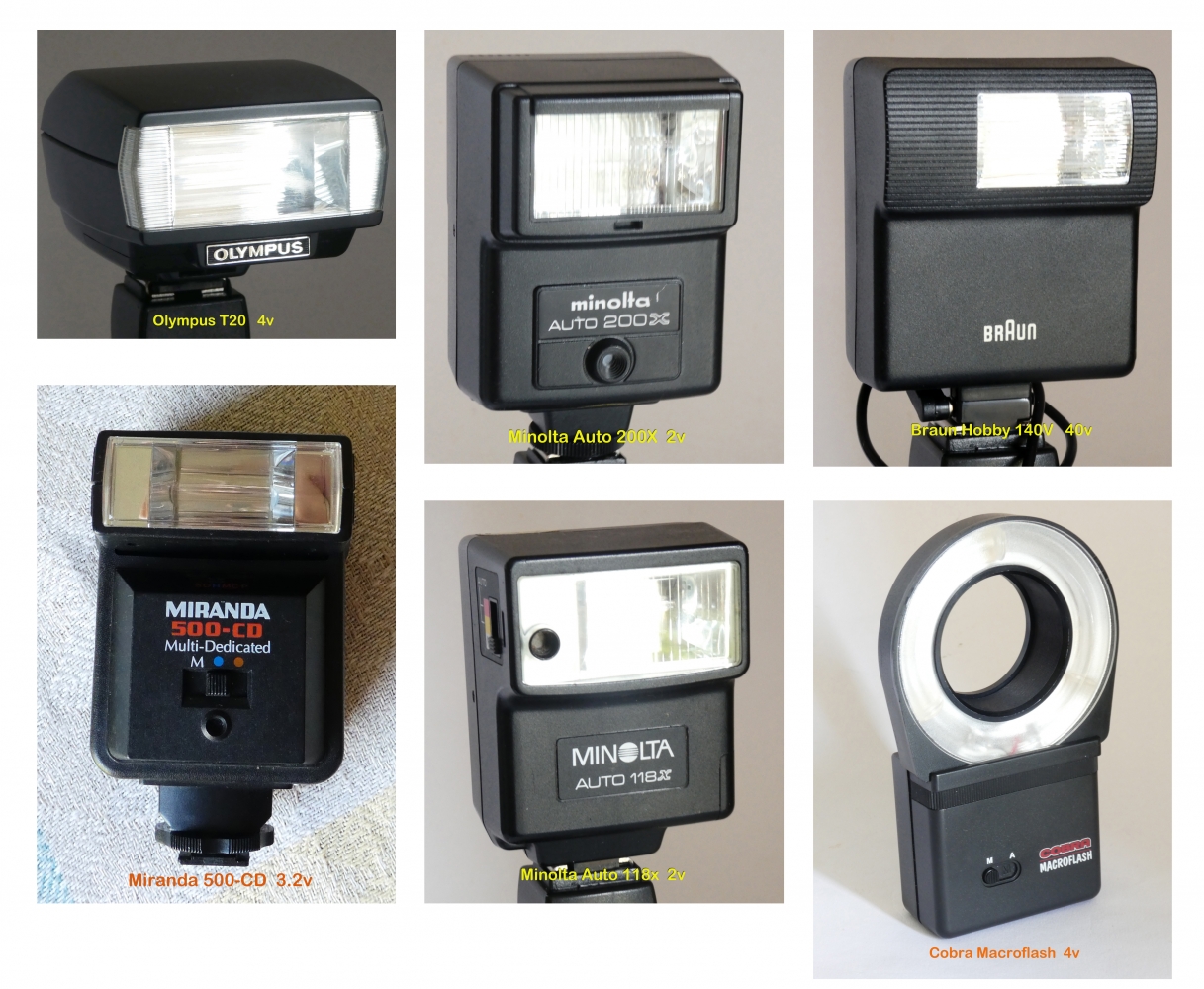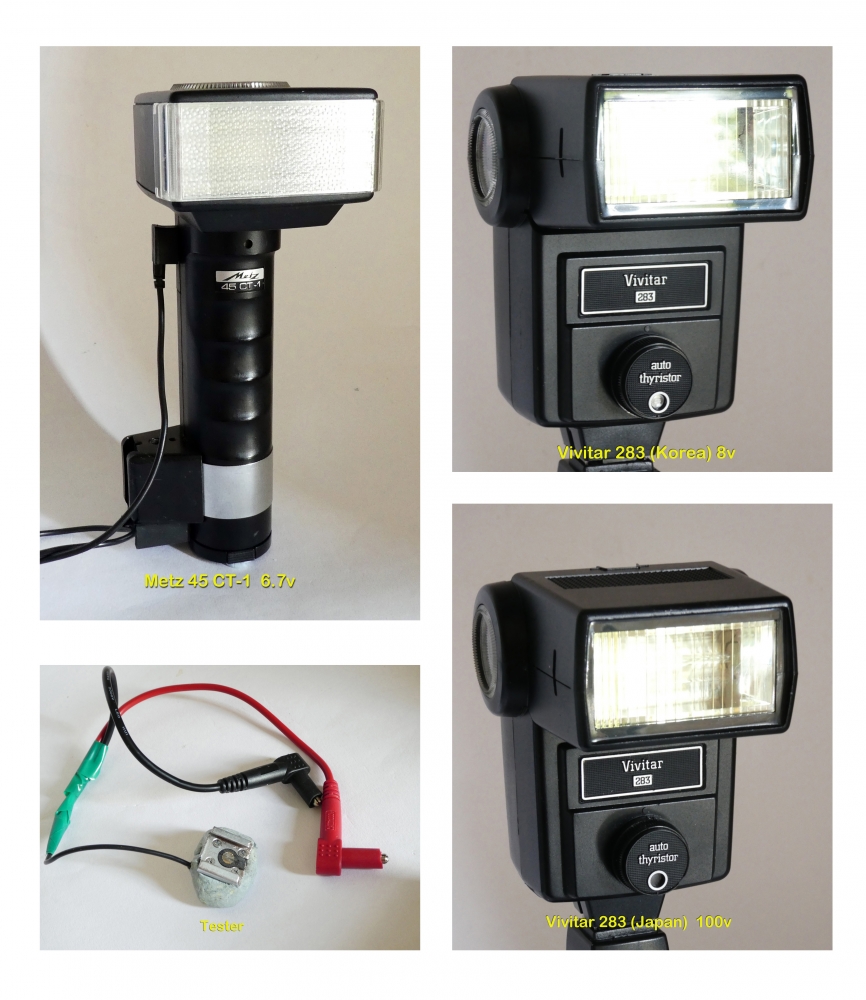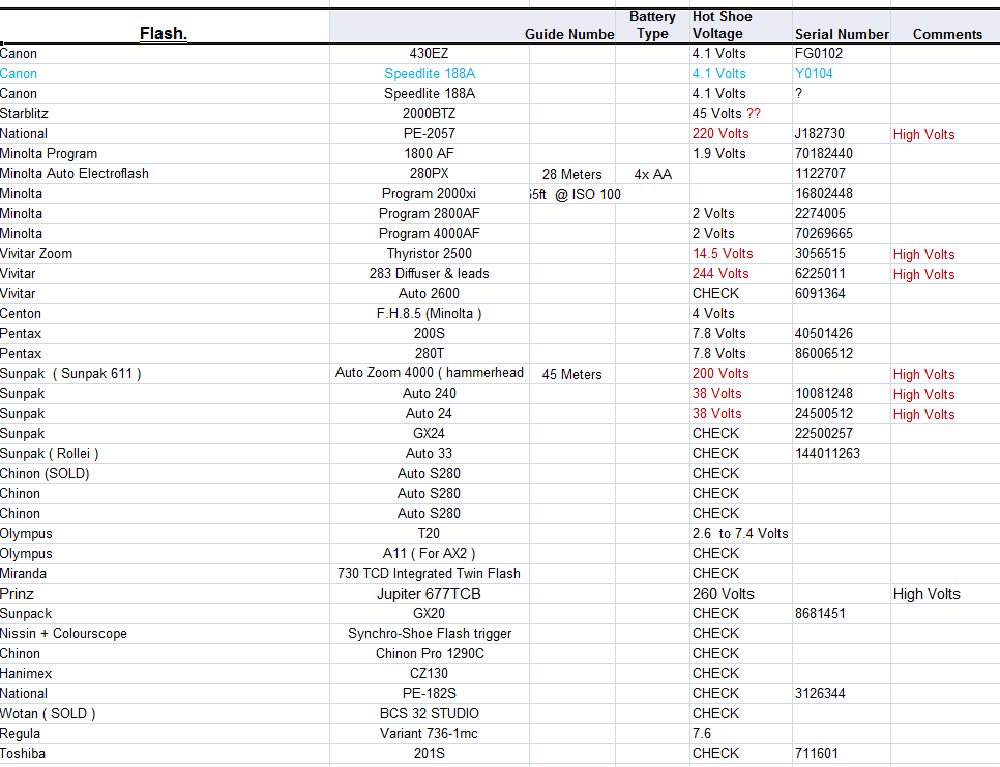| View previous topic :: View next topic |
| Author |
Message |
philslizzy


Joined: 07 Aug 2012
Posts: 4745
Location: Cheshire, England
|
 Posted: Sat Apr 11, 2020 2:58 pm Post subject: Old flash / strobes on digital cameras Posted: Sat Apr 11, 2020 2:58 pm Post subject: Old flash / strobes on digital cameras |
 |
|
philslizzy wrote:
WARNING It goes without saying that you must be careful about using old flashguns, designed for film cameras, on modern digital cameras because of the trigger voltage.
I have a drawer full of flashes, some bought in pawn shops, carboot sales or they came in boxes of stuff. Many years ago I bought a Wein SafeSync, this allows me to use any old flash on my digital camera as it has an opto-coupler, insulating the camera from the high voltage of the flashgun. But recently, out of curiosity, I measured the trigger voltage of all my flashguns to see what voltage they actually were. I was pleasantly surprised to see that most of them were low enough for my digital cameras. Out of nine randomly collected flashguns. only two would be considered unsafe for digital.
How to measure trigger voltage
You need a multimeter, digital is best but a scale version will suffice. Set it to 20v range, charge up the flashgun, when the ready light is on, touch the red + probe to the terminal (the large central contact) and the black - probe to the metal contact on the shoe of the flash. It should read the voltage. Sometimes though, you need three hands so I used a hot shoe to PC adapter, replacing the PC plug for a pair of probe cables. In this instance I have stuck a big lump of epoxy putty to the shoe to make it easier to remove. Occasionally the polarity is the other way round. For flashes without a hot shoe touch the outside of the plug with the - probe and the centre pin with the + probe.
I tried all my (safe) flashguns on my Olympus Pen5 with no ill effects. The Korean Vivitar 283 is now my flash of choice with my Sony A7. I have been using 283s since the 70's. The Korean one is probably my fifth, bought recently at a pawn shop for £5, I found the sensor lead for 92p at the same shop a year later.


_________________
Hero in the 'messin-with-cameras-for-the-hell-of-it department'. Official. |
|
| Back to top |
|
 |
DigiChromeEd


Joined: 29 Dec 2009
Posts: 3462
Location: Northern Ireland
|
 Posted: Sat Apr 11, 2020 3:34 pm Post subject: Posted: Sat Apr 11, 2020 3:34 pm Post subject: |
 |
|
DigiChromeEd wrote:
Thanks Phil, I have a new Vivitar 285HV (made in China) which gives a reading of 8V. I have been scared to use it on my Sony A6000; do you think the voltage is low enough?
_________________
"I've got a Nikon camera, I like to take a photograph" - Paul Simon |
|
| Back to top |
|
 |
philslizzy


Joined: 07 Aug 2012
Posts: 4745
Location: Cheshire, England
|
 Posted: Sat Apr 11, 2020 7:25 pm Post subject: Posted: Sat Apr 11, 2020 7:25 pm Post subject: |
 |
|
philslizzy wrote:
| DigiChromeEd wrote: |
| Thanks Phil, I have a new Vivitar 285HV (made in China) which gives a reading of 8V. I have been scared to use it on my Sony A6000; do you think the voltage is low enough? |
The 285, like the 283 is a powerful, versatile flash. I've settled on the 283 as it was my first 'serious' flash.
I'm shooting with the Vivitar 283 on my A6000 and A7 and that's 8 volts. Don't forget, the camera works with a 7+volt battery. But I wouldn't use 10v or higher on any camera without checking my camera model first. See this quote from dpanswers:
| Quote: |
Sony
For connection through a pc-socket, Sony lists the maximum safe trigger voltage in the manual (e.g. “Use a flash with a sync voltage of 400V or less.†Sony a700 manual, p. 77). However, this number does not apply to the hot-shoe. Sony does not officially give out information on the safe voltage for hot-shoe mounted flash units (beyond the obvious recommendation that you should only mount one of the Sony's own units in the hot-shoe).
However, user georgiaboy reports in a forum message on Dyxum.com that he has received the following information:
I spoke to a Sony tech support guy who said max voltage should not exceed 24 volts. |
To use an old flashgun: Set your camera to manual and set the shutter speed to the maximum for electronic flash. With the Sony A7 it is 1/250 and the A6000 its 1/160. I always use 1/125 (same as my film camera). Then set the aperture according to the scale on the flashgun. Make sure the ISO on the camera is the same as the ASA used on the flashgun scale. The flash will calculate the exposure. (assuming you have an auto model)
_________________
Hero in the 'messin-with-cameras-for-the-hell-of-it department'. Official. |
|
| Back to top |
|
 |
philslizzy


Joined: 07 Aug 2012
Posts: 4745
Location: Cheshire, England
|
 Posted: Sat Apr 11, 2020 7:30 pm Post subject: Posted: Sat Apr 11, 2020 7:30 pm Post subject: |
 |
|
philslizzy wrote:
I've been using the Metz with a Wein Safesync 
_________________
Hero in the 'messin-with-cameras-for-the-hell-of-it department'. Official. |
|
| Back to top |
|
 |
DigiChromeEd


Joined: 29 Dec 2009
Posts: 3462
Location: Northern Ireland
|
 Posted: Sat Apr 11, 2020 7:39 pm Post subject: Posted: Sat Apr 11, 2020 7:39 pm Post subject: |
 |
|
DigiChromeEd wrote:
 
_________________
"I've got a Nikon camera, I like to take a photograph" - Paul Simon |
|
| Back to top |
|
 |
DConvert


Joined: 12 Jun 2010
Posts: 921
Location: Essex UK
|
 Posted: Sun Apr 12, 2020 1:30 pm Post subject: Posted: Sun Apr 12, 2020 1:30 pm Post subject: |
 |
|
DConvert wrote:
| DigiChromeEd wrote: |
| Thanks Phil, I have a new Vivitar 285HV (made in China) which gives a reading of 8V. I have been scared to use it on my Sony A6000; do you think the voltage is low enough? |
There has been a range of voltages quoted by OEMs for what is considered safe, some claim a very conservative 5V, others quote as high as 24V. While some old flash units give out several hundred volts I think I measure 385 from one of mine. 
There are of course ways to use the high voltage flash units - I've seen an isolating trigger sold (far too much to be worthwhile IMO) & some optical slaves are OK with high voltages. Sadly most of my old flash units have packed up in the years since I last used them. |
|
| Back to top |
|
 |
KEO


Joined: 27 Sep 2018
Posts: 775
Location: USA
|
 Posted: Mon Apr 13, 2020 3:12 pm Post subject: Posted: Mon Apr 13, 2020 3:12 pm Post subject: |
 |
|
KEO wrote:
Great stuff, Phil.
I always enjoy reading your posts, thanks. |
|
| Back to top |
|
 |
cooltouch


Joined: 15 Jan 2009
Posts: 9096
Location: Houston, Texas
|
 Posted: Tue Apr 14, 2020 6:08 pm Post subject: Posted: Tue Apr 14, 2020 6:08 pm Post subject: |
 |
|
cooltouch wrote:
I did same as Phil when I found out about trigger voltage and went through all my strobes to find out which were safe to use. This was about 10 years ago, so I'm kinda hazy on the results, but as I dimly recall, I didn't find more than one or two that exceeded safe voltage levels. So that ended up giving me a big sigh of relief.
Like Phil, I have an old 283 I use. I still remember all the news conferences I watched back in the 80s and early 90s and how all of the photojournalists who weren't using handle-mounts were using 283s. All of them. So mine has become my "frontline" manual flash. Must be a Korean one, though, cuz I know the trigger voltage isn't anywhere near what that Japanese model has. My first "real" manual flash was the 285 that I bought back in the early or mid 80s, and I always liked it because of its zoom and the fact that it could take drop-in filters. I dunno what it is about the 285 that's different to the 283, though. I have two very clean late model (but vintage late model) 285s that are totally unresponsively dead. I resurrected my 283 by hooking it up to my Vivitar SB-4 charger and left it on for several days. That reformed the flash's capacitor -- and that was several years ago -- and it's been stone-cold reliable ever since. I tried the same with the 285s -- more than once, in fact, and they just stayed dead. I wouldn't mind getting a replacement, but I don't trust the Chinese when it comes to electronics. I have an almost 100% failure rate when it comes to Chinese electronics I buy, especially mail order or over the internet. And because of my two old dead 285s, I'm not all that trustful of used old ones either. So, 283 it is.
_________________
Michael
My Gear List: http://michaelmcbroom.com/photo/gear.html
My Gallery: http://michaelmcbroom.com/gallery3/index.php/
My Flickr Page: https://www.flickr.com/photos/11308754@N08/albums
My Music: https://soundcloud.com/michaelmcbroom/albums
My Blog: http://michaelmcbroom.com/blogistan/ |
|
| Back to top |
|
 |
Lloydy


Joined: 02 Sep 2009
Posts: 7798
Location: Ironbridge. UK.
Expire: 2022-01-01
|
 Posted: Wed Apr 15, 2020 12:27 am Post subject: Posted: Wed Apr 15, 2020 12:27 am Post subject: |
 |
|
Lloydy wrote:
There's a big variance in flash voltages, and I need to get my list up to date as well. 

_________________
LENSES & CAMERAS FOR SALE.....
I have loads of stuff that I have to get rid of, if you see me commenting about something I have got and you want one, ask me.
My Flickr https://www.flickr.com/photos/mudplugga/
My ipernity -
http://www.ipernity.com/home/294337 |
|
| Back to top |
|
 |
paulhofseth

Joined: 05 Mar 2011
Posts: 577
Location: Norway
Expire: 2018-06-28
|
 Posted: Sat Apr 18, 2020 12:17 pm Post subject: synchronization Posted: Sat Apr 18, 2020 12:17 pm Post subject: synchronization |
 |
|
paulhofseth wrote:
In my experience with Canon flash for film cameras, they do not work properly on the Canon digital. Probably due to a peculiar synchro delay.I have however, used Olympus ringflash with LeicaR and the PenF. The trick with adapting the ringflash to Leitz macro optics is to glue filter rings together.
p |
|
| Back to top |
|
 |
cooltouch


Joined: 15 Jan 2009
Posts: 9096
Location: Houston, Texas
|
 Posted: Sat Apr 18, 2020 2:58 pm Post subject: Re: synchronization Posted: Sat Apr 18, 2020 2:58 pm Post subject: Re: synchronization |
 |
|
cooltouch wrote:
| paulhofseth wrote: |
| In my experience with Canon flash for film cameras, they do not work properly on the Canon digital. |
I would go so far as to state that any flash intended for film cameras will not work reliably with a digital. I have a few quality flashes by Canon, Nikon, and Sony. Top of the line flashes in their day, but all intended for film cameras -- and relatively recent film cameras at that. Like EOS 1's and Nikon F4's and F5's, etc. The Canon and Sony do not work in any auto mode on my Canon and Sony digitals, although they do work fine in manual mode, and because they have fractional output, I can dial in the amount of flash I need. As for the Nikon, I don't own a Nikon digital, but I do own Nikon AF film cameras, so it gets used with them and with other chores, like slide duplication. All of these flashes are of a recent enough vintage where trigger voltage isn't a concern.
_________________
Michael
My Gear List: http://michaelmcbroom.com/photo/gear.html
My Gallery: http://michaelmcbroom.com/gallery3/index.php/
My Flickr Page: https://www.flickr.com/photos/11308754@N08/albums
My Music: https://soundcloud.com/michaelmcbroom/albums
My Blog: http://michaelmcbroom.com/blogistan/ |
|
| Back to top |
|
 |
paulhofseth

Joined: 05 Mar 2011
Posts: 577
Location: Norway
Expire: 2018-06-28
|
 Posted: Sat Apr 18, 2020 4:03 pm Post subject: timing v\s output adjustment Posted: Sat Apr 18, 2020 4:03 pm Post subject: timing v\s output adjustment |
 |
|
paulhofseth wrote:
Long time since I used flah, but I am under the impression that the problem was in the timing of when the flash starts, since I would have been quite happy with calculating aparture based on the guide number. The auto features usually had a measuring device either on the flash or in the camera (communicating to regulate the flash) following from changing systems for igniting the flash ,older systems failed. Another annoying producer habit was to change plug types.
p. |
|
| Back to top |
|
 |
philslizzy


Joined: 07 Aug 2012
Posts: 4745
Location: Cheshire, England
|
 Posted: Mon Apr 20, 2020 11:54 pm Post subject: Re: timing v\s output adjustment Posted: Mon Apr 20, 2020 11:54 pm Post subject: Re: timing v\s output adjustment |
 |
|
philslizzy wrote:
| paulhofseth wrote: |
Long time since I used flah, but I am under the impression that the problem was in the timing of when the flash starts, since I would have been quite happy with calculating aparture based on the guide number. The auto features usually had a measuring device either on the flash or in the camera (communicating to regulate the flash) following from changing systems for igniting the flash ,older systems failed. Another annoying producer habit was to change plug types.
p. |
I never thought about timing. I just used the shutter speed for flash on my camera and it worked every time.
Regards plug types. After the start of the 60s most cameras and electronic flash used the common pc socket. Anything earlier than that is likely to be bulb flash anyway. Triggering at anything over 15 volts depending on the battery. That's where the flash timing could be a problem. Although in old film cameras with only X sync, a 15th or 30th would be enough.
_________________
Hero in the 'messin-with-cameras-for-the-hell-of-it department'. Official. |
|
| Back to top |
|
 |
|
|
|
You cannot post new topics in this forum
You cannot reply to topics in this forum
You cannot edit your posts in this forum
You cannot delete your posts in this forum
You cannot vote in polls in this forum
|
